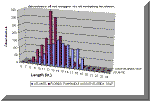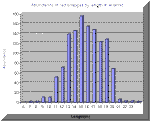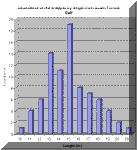RED SNAPPER
(Lutjanus campechanus)
The size (legal & sub-legal) of each target fish (red grouper, gag, red snapper & vermilion snapper) caught per trip, is being recorded. The following length/ frequency graphs show the distribution of that species by the area fished. Fish from neighboring locations were grouped into the
nearest area. therefore, some areas have fewer graphs than others. This thumbnail, when selected, gives a full size graph showing the location and frequency of the target species throughout the study area. distribution of that species by the area fished. Fish from neighboring locations were grouped into the
nearest area. therefore, some areas have fewer graphs than others. This thumbnail, when selected, gives a full size graph showing the location and frequency of the target species throughout the study area.
|
Select a thumbnail for a full size graph of the specific location |
|
 |
 |
 |
|
Atlantic |
Florida Panhandle |
South Florida Gulf |
MML Researchers to Conduct Tag Shedding Study
MML personnel are presently conducting a double tag study to evaluate the problem of lost tags. This will be accompanied by tagging with both PIT and Hallprint plastic dart tags, as, without proper tag-shedding
rates, it is difficult to determine survival return rates. Minute rice-grain sized PIT (Passive Integrated Transponder) tags are injected into the musculature of the fish. This enables MML personnel to scan all red snapper caught
through a digital read out of the tag.
|
Double Tagged Fish
1/1/1990 - 3/7/2003
29 Fish
|
Subarea |
Tag Depth Feet |
Distance Travelled |
Days of Freedom |
|
DUNEDIN |
138 |
0 |
70 |
|
JACKSONVILLE |
75 |
0 |
110 |
|
JACKSONVILLE |
75 |
0 |
231 |
|
JACKSONVILLE |
80 |
19 |
52 |
|
PANAMA CITY |
87 |
0 |
188 |
|
PANAMA CITY |
88 |
|
256 |
|
PANAMA CITY |
88 |
|
312 |
|
PANAMA CITY |
92 |
|
83 |
|
PANAMA CITY |
98 |
|
281 |
|
PANAMA CITY |
98 |
|
429 |
|
PANAMA CITY |
110 |
1 |
57 |
|
PANAMA CITY |
110 |
1 |
327 |
|
PANAMA CITY |
111 |
0 |
170 |
|
PANAMA CITY |
111 |
0 |
188 |
|
PANAMA CITY |
114 |
0 |
316 |
|
PANAMA CITY |
116 |
0 |
170 |
|
PANAMA CITY |
116 |
237 |
179 |
|
ST. ANDREW'S SOUND GA |
65 |
0 |
198 |
|
ST. AUGUSTINE |
63 |
0 |
19 |
|
ST. AUGUSTINE |
63 |
0 |
59 |
|
ST. AUGUSTINE |
63 |
18 |
188 |
|
ST. AUGUSTINE |
65 |
60 |
26 |
|
ST. AUGUSTINE |
70 |
0 |
11 |
|
ST. AUGUSTINE |
70 |
0 |
21 |
|
ST. AUGUSTINE |
70 |
0 |
30 |
|
ST. AUGUSTINE |
70 |
0 |
108 |
|
ST. AUGUSTINE |
70 |
0 |
122 |
|
ST. AUGUSTINE |
103 |
1 |
443 |
|
TARPON SPRINGS |
98 |
0 |
30 |
|
Return to Top
Experiments to Evaluate Depth-related Capture-Release Mortality
Conducted by FSU Scientists: Drs. Felicia Coleman and Chris Koenig
At various depths undersized specimens of the target species will be captured, measured, marked, freeze-branded and returned to the bottom in special
cylindrical cages. The caged fish will then be observed by Scuba divers after capture, brought to the surface and transported to the FSUML holding facility for further testing to determine sub-lethal effects of depth.
Return to Top
"Partitioning Release Mortality in the Undersized Red Snapper Bycatch"
This is a study group composed of Karen M. Burns (Staff Scientist/Program Manager of Fish Biology) of Mote Marine Laboratory and Dr. Raymond R. Wilson, Jr., Associate Professor of Marine Science, Department of Biological
Sciences, California State University, Long Beach, as co-principal investigators.
The goals and objectives of this project are to determine the ramifications of current practices in the bycatch of undersized red snapper,
and to then test and evaluate to determine successful directions for future practices to assure the survival of this important commercial and recreational resource. The use of specific hook types and sizes, such as the J, kahle,
and circle hooks, will be investigated and will be an important adjunct to previous studies in this area. See the new article relating to this study.
Depth induced mortality of red snapper will be investigated in the laboratory by simulating depth of 140 and 200 feet using Dr. Wilson's fish hyperbaric chambers.
The project will enhance the scope of on-going studies
involving other species of undersized reef fish, i.e. hook mortality, physiological effects of depth, predation, etc. and become a valuable information source for scientists, marine
regulatory groups, commercial fishermen and sportsmen.
For a complete listing of tagged and recaptured Red Snapper, from April 1999 through October 23, 2001, please visit the Red Snapper Statistics page.
Return to Top
Return to Fish Biology
Last update:
June 15, 2004
|
 distribution of that species by the area fished. Fish from neighboring locations were grouped into the
nearest area. therefore, some areas have fewer graphs than others. This thumbnail, when selected, gives a full size graph showing the location and frequency of the target species throughout the study area.
distribution of that species by the area fished. Fish from neighboring locations were grouped into the
nearest area. therefore, some areas have fewer graphs than others. This thumbnail, when selected, gives a full size graph showing the location and frequency of the target species throughout the study area.